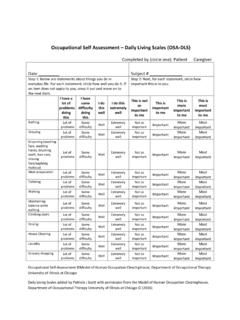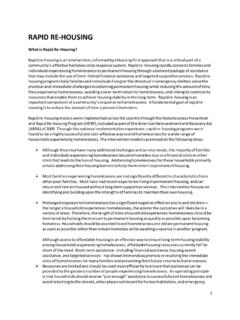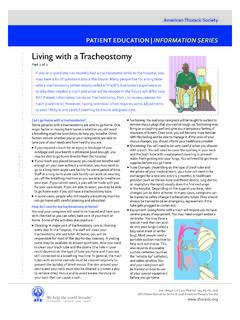Transcription of The Maya Calendar System - Living Maya Time
1 ~ 1 ~ 1 The Maya Calendar SystemUsing their knowledge of astronomy and mathematics, the Maya developed one of the most accurate cal-endar systems in human history. The Maya Calendar System has its roots in older, Mesoamerican1 indig-enous civilizations, particularly the Olmec. The Maya Calendar is complex and serves both practical and ceremoni-al purposes. The Maya Calendar System includes several calendars that mea-sure time periods of varying lengths. These calendars are based on solar, lunar, planetary, and human cycles. There are three most commonly known cyclical calendars used by the Maya. These include the Haab which is a 365-day solar Calendar , the Tzolk in which is a 260-day sacred Calendar , and the Calendar Round of 52 years.
2 In addition, the Maya developed the Long Count Calendar to date mythical and historical events chronologically. 1 Definitions for words in red-colored font can be found in the Glossary page in the Resources section of the Living Maya Time contemporary representation of the Tzolk in (inner green circle) and Haab (outer brown circle) HaabThe Maya solar Calendar , called Haab, is a count of 365 days and thus approximates the solar year. The word haab means year in the Yucatec Mayan language. The Haab is composed of 18 months made of 20 days each, plus one month made of 5 days. A month made of 20 days is called a uinal. Each uinal has its own name. These 18 months together equal 360 days.
3 The last month made of 5 days is called Wayeb. The 19 months together total 365 days. 18 x 20 + 5 = 3652 Table 1: Haab Months and DaysPopWo SipSotz SekXulYaxk inMolCh enYa xSak KehMakK ank inMuwanPaxK ayabKumk uWayeb0000000000000000000111111111111111 1111222222222222222222233333333333333333 3344444444444444444445555555555555555556 6666666666666666677777777777777777788888 8888888888888999999999999999999101010101 0101010101010101010101010101111111111111 1111111111111111111111112121212121212121 2121212121212121212131313131313131313131 3131313131313131414141414141414141414141 4141414141415151515151515151515151515151 5151515161616161616161616161616161616161 6161717171717171717171717171717171717171 8181818181818181818181818181818181819191 9191919191919191919191919191919 Table 1 shows the Yucatec Mayan names for the Haab
4 Months. The 20 days are counted from 0 to 19. The 19th month is the Wayeb. This last month of 5 days is counted from 0 to 4. The Maya farmers of the Yucatan follow the Haab Calendar . The farmers conduct offerings and ceremonies on the same months every year. These ceremonies are the Sac Ha , Cha a Chac and Wa j i k o l. The farmers ask for rain and make offerings during the growth cycle of the corn, especially during its planting and harvesting. The Maya in the highlands of Guatemala perform special ceremonies and rituals during the Haab month of Wayeb, the short month of five days. 3 Maya women of San Sim n, Yucat n, M xico prepare the Sac Ha' sacred beverage with ground corn, water collected from morning dew or from a cave, and honey.
5 A Maya elder from Peto, Yucat n, performs the Sac Ha' ceremony at the archaeological site of Uxmal. During the ceremony, he petitions for rain and for the well-being of Maya workers at the site. He also gives thanks for the offerings of the image: The hieroglyphs corresponding to the nine-teen months of the Haab Calendar . The Maya represented some of these months using more than one glyph. These are referred to as variants. Variants of the same glyph are framed in a turquoise background. For example, the month Pop shown in the upper left corner of the image has two variants. The month of Wayeb on the lower right also has two Tzolk in The sacred Maya Calendar is called Tzolk in in Yucatec Mayan and Chol Q ij in K iche.
6 This Calendar combines 20 named days with 13 numbers that, when multiplied, amount to 260 days. The length of the Tzolk in, 260 days, matches nine cycles of the Moon and the gestational period of humans. The Tzolk in is also related to the movements of the Sun and the growing cycle of corn. Table 2 shows the name of each month in Yucatec Mayan and in K iche .Table 2: Names of the Days in the Sacred Maya CalendarChol Q ij K iche Tzolk in Yucatec MayanB ATZ CHUWENEEB AJB ENI XIXTZ IKINMENAJMAQK IB N O JKAB ANTIJAXETZ NAB KAWOQK AWAKAJPU A JAWIMOXIMIX IQ IK A Q A B A LAK B ALK ATK A NKANCHIKCHANKAMEKIMIKEJMANIK Q ANILL A M ATTOJMULUKTZ I OK5 Hieroglyphs corresponding to the twenty days of the Tzolk in.
7 The day Imix is on the upper left of the image and Ajaw is on the lower Maya representation of the Tzolk in from the Madrid Codex. Time is represented by 260 dots marking a path or a journey of twenty days and thirteen 3: Chol Q ij Calendar Day Names and NumbersB ATZ EAJI XTZ IKINAJMAQN O JTIJAXKAWOQAJPU IMOXIQ A Q A B A LK ATKANKAMEKEJQ ANILTOJTZ I 1234567891011121312345678910111213123456 7891011121312345678910111212345678910111 2131234567891011121312345678910111213123 4567891011121312345678910111213123456789 1011121312345678910111213123456789101112 1312345678910111213123456789101112131234 5678910111213123456789101112131234567891 0111213123456789101112131234567891011121 312345678910111213 Each day name of the Tzolk in is tied to a number from one to thirteen.
8 A full cycle of 260 days is not com-plete until every one of the thirteen numbers is attached to every one of the twenty day names. Table 3 shows the progression of day names in K iche , the corresponding sequence of numbers, and how to read them. The flow of time weaves its way through the Calendar . Guatemalan Day Keepers say that time moves through the Calendar like a serpent. 7 Printed Tzolk'in calendars are popular in the Yucat n. The Chol Q ij printed Calendar is used daily by many people in the highlands of representation of the Feathered Serpent, called Q'ukumatz in K'iche'or Kukulk n in Yucatec Poz P rez, K'iche', is a Calendar Day Keeper in a village near Quetzaltenango, new year is welcomed at every occurrence of the Tzolk in date 8 Chuwen (8 B atz in K iche ).
9 The new year recurs every 260 days. The K iche Ajq ijab in the highland areas of Guatemala celebrate the new year with a ceremony called Waxjaqib B atz . During this ceremony, new Calendar Day Keepers are initi-ated. 8 The Calendar RoundThe complete name of any given date in the Maya Calendar System consists of both a Tzolk in date and a Haab date. The Calendar Round is made from the interweaving of the Tzolk in and Haab calendars. In the Calendar Round, a given combination of Tzolk in and Haab will not repeat itself until 52 periods of 365 days have passed. This is based on the mathematical concept of the least common denominator and the least common multiple.
10 Both 260 and 365 are divisible by 5, and 260 divided by 5 is 52, while 365 divided by 5 is 73. Thus, the least common multiple of 260 and 365 is 5 x 52 x 73 =18,980. A Calendar Round thus equals 18,980 days, 52 x 365, or 52 Haab years. The Maya believe that when a person reaches 52 years of age, they attain the special wisdom of an elder. A Calendar Round date, with both Tzolk in and Haab components, is able to uniquely mark an event within a 52 year period. However, any event spanning more than 52 years required an additional Calendar , the Long Count Calendar . A contemporary representation of the Calendar Round, interlocking the Tzolk in (left) with the Haab (right).9 Long Count Time Cycles1 k in, or 1 day20 kin1 uinal, 20 days18 uinal1 tun, or 360 days20 tun1 katun, or 7,200 days20 katun1 baktun, or 144,000 daysThe Long CountThe ancient Maya also used a Calendar System called the Long Count.









